|
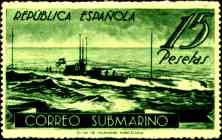
|
Maritime Topics On Stamps :
Submarines, Part 2,
1776 - 1939.
|
|
Spanish sub 'D1' of 1933
|
|
Our first page of the topic
'Submarines' describes research submersibles.
This new page is our second part covering naval submarines from their
earliest beginnings until the outbreak of World War Two.
The third part, reporting on the years 1939 - 2000, you'll find at the bottom at 'next page'.
|
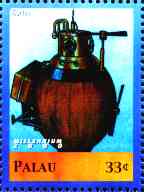
|
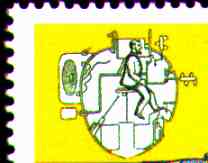
|
|
The world’s first combat submarine was David Bushnell’s ‘Turtle’, a one-man
sub built in 1776 and driven by hand-cranked water screws, as shown on
stamp detail at right. On Oct.7,1776, Turtle was to attack Admiral Howe’s
flagship Eagle in New York Harbor. Volunteer operator was Sgt. Ezra Lee. A
150 lb bomb with timed fuse was to be attached to the enemy’s bottom by means
of a drill. The attempt was unsuccessful, foiled by the ship’s copper bottom.
Enemy guards chased sub but Turtle escaped.
|
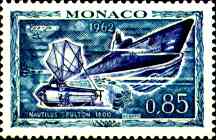
|
In 1800 Robert Fulton, an American living in France, invented a submarine he named
Nautilus.
Propulsion was by sails on the surface and a hand-cranked propeller while submerged.
Fulton performed a number of successful dives down to depths of 8 meters, four times
with six hours under water. A pipe leading to the surface supplied air to breathe.
When the French Navy refused to purchase the boat, Fulton sold it for scrap.
|
|
Russian inventor K.A. Schilder constructed a boat regarded as the first all-metal
submarine, in 1834. The stamp clearly shows its spar torpedo, a long pole with a
bomb fastened to the end.
|
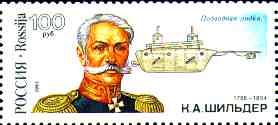
|
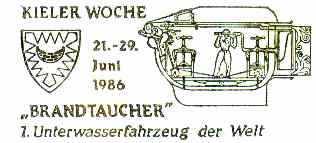
|
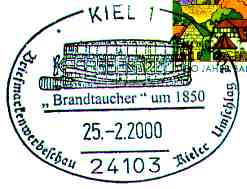
|
|
When Danish warships blockaded Germany’s coasts in 1850, Wilhelm Bauer developed a
three-man boat he called Brandtaucher (Fire Diver). Two persons hand-cranked the
propeller. The sub had sophisticated trimming tanks and air circulation vents.
During its first test dive in Kiel Harbor on Feb.1, 1851, the boat sank to the bottom
13 meters below . The crew managed to struggle to the surface several hours later.
Recovered in 1887, the boat is exhibited in a Kiel museum, soon to be transferred to
Dresden. The commemorative handstamp on the left shows an preliminary design, the
one on the right the finished construction.
|
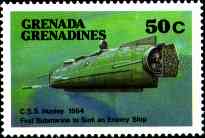
|
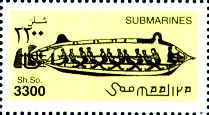
|
|
America’s Civil War saw the first submarine ever to sink an enemy vessel: The
South’s C.S.S. H.L. Hunley, named after her sponsor and designer H.L. Hunley, cotton
planter and lawyer. Built at Mobile, Alabama, in 1863, with a cylindrical iron hull,
she had diving fins, ballast tanks for submersion, and an eight-man crew, seven
of whom worked the hand-cranked propeller. She sank three times during trials in
Mobile and Charleston, South Carolina, drowning two volunteer crews including her
sponsor. Yet another crew soon formed, led by Lt. G.E. Dixon as the sub’s captain.
During the night on Feb.17, 1864, the floating coffin succeeded in ramming its spar
torpedo into the U.S.S. Housatonic. The explosion sank the Union vessel, however,
the little submarine with its last volunteers also disappeared. Lost for 131 years,
the Hunley was rediscovered in 1995 by renowned author Clive Cussler. In remarkably
good condition, she was raised in 2000 and is now under conservation and study in
Charleston, South Carolina. [The Grenada Grenadines stamp shows the Hunley submerged,
but with an open conning tower... What was the stamp designer smoking?]
|
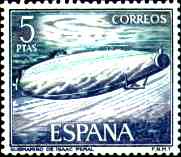
|
1867 British inventor Alfred Whitehead developed a self-propelled mine he called
'automobile torpedo'. 1869 saw the U.S. Navy starting to produce Whitehead torpedoes.
1888 Spanish inventor Isaac Peral built the submarine named after him, 21m long,
with two 30 HP motors, and one torpedo tube. The following year Peral conducted three
successful trials using Whitehead torpedoes. Yet, he did not generate sufficient
support for his invention. Today the boat can be seen in Cartagena, Spain.
|
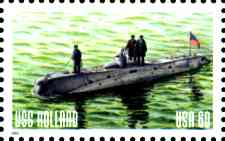
|
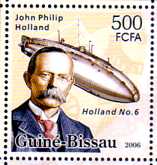
|
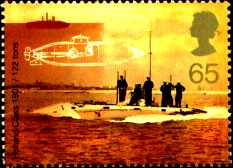
|
The American engineer John Philip Holland was an outstanding submarine construction
pioneer. His first sub was developed in 1878, as shown on
our page Submarines Part I.
In April 1900 the U.S. Navy bought his sixth sub and named it U.S.S. Holland
(stamps above), the first boat of the U.S. submarine service.
The same year
Britain's Royal Navy contracted with Holland as well, building five subs under license.
| |
These were the first submarines under the White Ensign, stamp left. The specs: 62 ft length,
11.5 ft breadth, 122 tons Displacement, 7.5 knots on surface, 6 knots submerged.
One torpedo tube with three torpedoes. The crew: Eight naval personnel and three
white mice, to signal any development of dangerous vapors.
|
|
Commencing in 1901, the British built 13 boats of the ‘A class’. These subs were
155 ft long, 18 ft wide; with speeds of 9.5 knots on surface and 6 knots submerged;
one torpedo tube; and a crew of twelve.
|
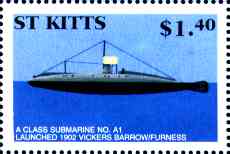
|
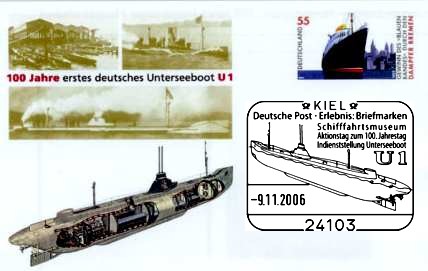
|
|
During this time the Germans developed their
first submarine named ‘U-1’. Launched in 1906,
it was 138 ft long, 13 ft wide, with speeds of 11 knots on surface and 9 knots under
water; 239 tons Displacement; twin screws, 1,536 miles range; one tube; crew of 22.
|
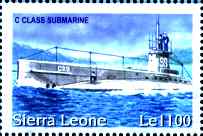
|
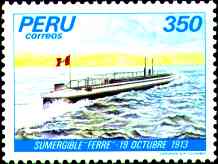
|
|
From 1906 until 1910 Britain constructed 39 boats of the ‘C-class’, which also saw
action in World War One. The specs: 141 ft long, 13 ft wide, speed 12/7.5 knots,;
displacing 290 tons; a range of 1,431 miles; two tubes; 16-man crew. Stamp at right
depicts the Peruvian submarine ‘Ferre’, built 1912. Specs: 151 ft long, 15 ft wide,
12.7/8 knots; 300 tons displacement; one torpedo tube in the bows, another four in
its superstructure.
|
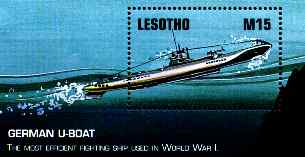
|
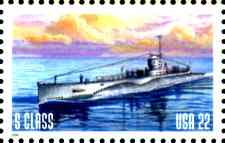
|
|
By the time World War One broke out, submarines had evolved into a most fearsome
weapon. Here we see two of the boats in action at the time. The stamp on the left is
supposedly depicting a German U-boat. Taking the specs of U-9 which sank three British
cruisers early in the war in 1914: Length 266 ft, breadth 31 ft, 14 knots surface
and 8 knots submerged speed; two torpedo tubes in the bows, two in the stern; a 29-man
crew. At this time the deck gun was introduced to force merchant ships to surrender,
and to sink them while saving on torpedoes. Following the United States' entry in the
war, subs of the S-class as pictured here made their debut. Specs of 'S-28': 210 ft
long, 21 ft wide, 14.5 and 11 knots above and below, respectively; displacement 850
tons; four tubes; 3,420 miles range. Several S-class boats saw service still during
World War Two.
|
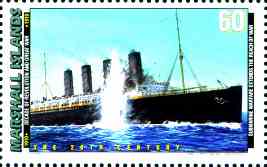
|
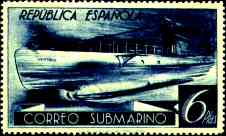
|
|
In May 1915 U-20 sank the British passenger liner 'Lusitania'. The sub commander
assumed her to be an armed troop transport. Lots of books with different view points
have been published regarding this incident, nevertheless we know today as proven fact
that the vessel carried arms and ammunition on behalf of the British Admiralty,
endangering the lives of her passengers and crew. At the outset of World War One,
Germany disposed of 26 U-boats; 390 more were added during the course of the war.
178 submarines were lost, and 5,364 German U-boat sailors never returned. German boats
sank more than 4,500 vessels with approx. 11 million tons. During 1917 alone the number
of sunken ships reached 3,170; in 1918 another 1,280 followed the same fate.
And tens of thousands of seamen perished in this brutal war at sea.
On the right we see the Spanish submarine 'A1', ex-Narciso Monturiol, built 1916 at
La Spezia.
|
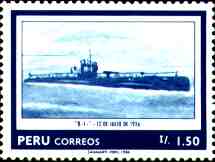
|
Here now some examples regarding submarines at the time between both World Wars.
The 'R1' was built for the Peruvian Navy in 1926 by the Electric Boat Company
in Quincy, Mass. After reconstruction in 1935 and 1950, the boat was renamed
'Islay' in 1957, and de-commissioned 1960. Her specs: 184 ft long, 17 ft wide,
14.5/9.5 knots; 576 tons displacement; four torpedo tubes; 30-man crew.
|
|
Here we see the Soviet boat 'Krasnogvardeec' built 1932 in Leningrad and in action
in the Northern Seas since 1941. Went missing during 1942, probably sunk by German
mines. The sub was 240 ft long, displaced 900 tons, and was armed with eight torpedo
tubes.
|
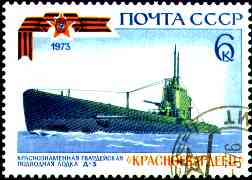
| |
Maximum diving limits of the boats were closely guarded secrets. It is known, however,
that in 1914 U.S.S. Seal reached a depth of 256 feet. German U-boats after 1935 were
diving down safely to 656 feet without any risk of hull damage.
|
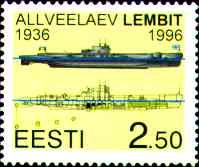
|
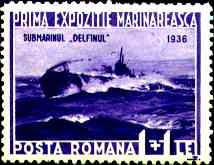
|
|
On the left we see the Estonian sub 'Lembit' built in England and commissioned in
1936. On the right is the 'Delfinul', constructed in Italy in 1927 and taken over by
Romania's navy during 1936. She was equipped with eight torpedo tubes. After World War
One, the Treaty of Versailles forbade Germany to build any submarines. Yet,
clandestinely, Germans continued to develop subs at yards in the Netherlands and Japan.
When the German-British Naval Treaty of1935 lifted most restrictions, it took just a
few weeks for the German Navy to present its new boat 'U-1' to the world.
|
If you like to see our first part about the research submersibles, click on this line.
If you like to see our third page, covering naval submarines
from the outbreak of WW II up to today,
click on this line.
If you like to see our page about the Atlantic-Battle during WW II,
click on this line.
|